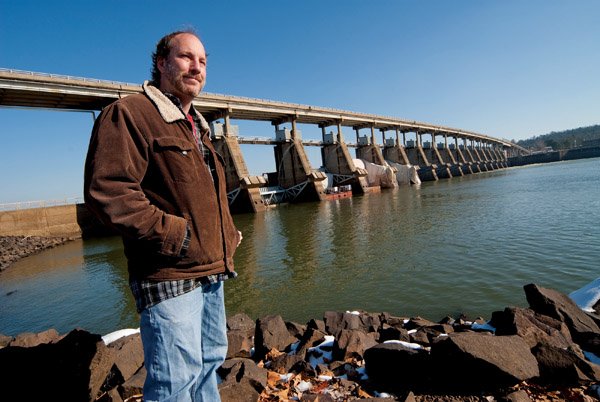CONWAY — The city of Conway will hold a public hearing at 7 p.m. Tuesday at the District Court building to discuss planning and zoning for Conway Corp.’s proposed sewage-treatment facility in the Tupelo Bayou.
Mark Spitzer, a professor of writing at the University of Central Arkansas in Conway, plans to be there, and Conway Corp. CEO Richie Arnold isn’t surprised.
“Professor Spitzer spoke at the first public hearing that we held about this, so I’m familiar with his concerns,” Arnold said.
Spitzer really only has one concern: gar.
Alligator gar are found throughout the South and are endangered in several areas, including Arkansas.
Last April, Spitzer published a book called Season of the Gar: Adventures in Pursuit of America’s Most Misunderstood Fish. Spitzer is regarded as the foremost “gar expert,” he said.
Spitzer said he thinks the gar are interesting because of their physical features.
“They can grow up to 12 feet long,” he said. “They have an alligator-shaped head with giant teeth, armored scales that are sometimes bullet proof, and they can breathe air.”
Spitzer’s book recounts the history of the species. He said that when settlers arrived in Arkansas in the 1800s, they began a campaign to wipe out the species. Then in the 1950s, gar became a popular sporting fish.
Spitzer works with the Arkansas Game and Fish Commission, as well as U.S. Fish and Wildlife experts, to grow the population of alligator gar in Arkansas.
“They are an important part of our state’s national habitat because they even out all the rough fish that destroy the habitats of others first,” Spitzer said.
More specifically, alligator gar are one of the only species who eat silver carp.
“Silver carp are notorious for jumping out of the water,” said field biologist Lee Holt with the Arkansas Game and Fish Commission. “They are an invasive species that have really taken off, and that’s one benefit the alligator gar offer.”
Spitzer believes Conway Corp.’s plans for a sewage plant would threaten the gar population in the Tupelo Bayou.
Arnold disagreed.
“We have not had any indication from anybody that they were concerned about any negative impact on the gar,” he said. ”There is no requirement that we do anything as far as studying the impact on the gar. As far as I know, there is nothing that requires us to examine it.”
Representatives from the Arkansas Game and Fish Commission were unfamiliar with Conway Corp.’s plans for the sweage plant.
“As far as any type of impact that it would have on a particular area, I’m very reluctant to talk about it because I just don’t know,” Holt said.
At the public hearing, Spitzer said, he plans to protest Conway Corp.’s plans.
“The ground being treated here has the largest known population of alligator gar in the state,” he said. “We can’t just put in a sewage plant without doing an environmental-impact study.”
In an e-mail, Spitzer wrote to a group of Arkansas Game and Fish Commission and U.S. Fish and Wildlife representatives — people he considers “friends of the gar.” He said he will speak on behalf of the gar and asked others who share his concerns to join him.
“My concerns are that constructing the plant might harm the next spawn and that water levels and water temperatures in Tupelo Bayou could be altered in such a way so as to make future spawns less effective,” Spitzer wrote.
Spitzer said Conway Corp. officials don’t seem too interested in working with the community or biologists at UCA to learn about the environmental impact of the project.
“I’ll give you 70 million reasons why,” Spitzer said.
Faulkner County Judge Preston Scroggin said the project will cost about $70 million to complete.
Arnold confirmed that the corporation does have a commitment from a revolving loan fund for that amount.
“The project is about 90 percent designed at this point,” Arnold said. “When the design is complete, we will be taking bids on the project. It is currently planned to be an 8-million-gallon-per-day treatment facility.”
Conway Mayor Tab Townsell could not be reached for comment.
